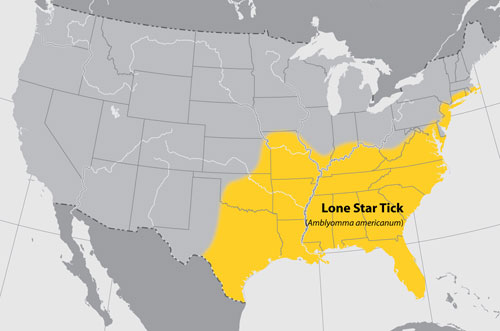Questions and Answers
- What is ehrlichiosis?
- How do people get ehrlichiosis?
- What are the symptoms of ehrlichiosis?
- In the United States, where do most cases of ehrlichiosis occur?
- How is ehrlichiosis diagnosed?
- How is ehrlichiosis treated?
- Can a person get ehrlichiosis more than once?
- How can ehrlichiosis be prevented?
What is Ehrlichiosis?
Ehrlichiosis is the general name used to describe several bacterial diseases that affect animals and humans. These diseases are caused by the organisms in the genus Ehrlichia. In the United States, there are currently two ehrlichial species that are known to cause disease in humans: Ehrlichia chaffeensis and Ehrlichia ewingii. Ehrlichia chaffeensis causes human ehrlishiosis also described as human monocytic ehrlichiosis (HME). In addition, human infections with Ehrlichia ewingii have also been documented.
How do people get ehrlichiosis?
In the United States, ehrlichiae are transmitted by the bite of an infected tick. The lone star tick (Amblyomma americanum) is the primary vector of both Ehrlichia chaffeensis and Ehrlichia ewingii in the United States.
What are the symptoms of ehrlichiosis?
The symptoms of ehrlichiosis may resemble symptoms of various other infectious and non-infectious diseases. The initial signs and symptoms generally include:
- fever
- headache
- fatigue
- muscle aches
Other signs and symptoms may include:
- nausea
- vomiting
- diarrhea
- cough
- joint pains
- confusion
- occasionally rash
Symptoms typically appear after an incubation period of 5-10 days following the tick bite. It is possible that many individuals who become infected with ehrlichiae do not become ill or they develop only very mild symptoms.
In the United States, where do most cases of ehrlichiosis occur?
Most cases of ehrlichiosis are reported from the southern, eastern, and south-central United States, corresponding to the geographic distribution of the Lone Star tick. Cases may also be reported outside the expected range of this tick related to travel to endemic areas, or misclassification of cases that are more likely attributable to anaplasmosis. If you traveled to an ehrlichiosis-endemic area 2 weeks prior to becoming ill, you should tell your doctor where you traveled.

Areas where human ehrlichiosis may occur based on approximate distribution of vector tick species.
How is ehrlichiosis diagnosed?
A diagnosis of ehrlichiosis is based on a combination of clinical signs and symptoms and confirmatory laboratory tests. Your doctor can send your blood sample to a reference laboratory for testing. However, the availability of the different types of laboratory tests varies considerably. Other laboratory findings indicative of ehrlichiosis include low white blood cell count, low platelet count, and elevated liver enzymes.
How is ehrlichiosis treated?
Ehrlichiosis is treated with a tetracycline antibiotic, usually doxycycline.
Can a person get ehrlichiosis more than once?
Very little is known about immunity to ehrlichial infections. Although it has been proposed that infection with ehrlichiae confers long-term protection against reinfection, there have been occassional reports of laboratory-confirmed reinfection. Short-term protection has been described in animals infected with some Ehrlichia species and this protection wanes after about 1 year. Clearly, more studies are needed to determine the extent and duration of protection against reinfection in humans.
How can ehrlichiosis be prevented?
See the Tickborne Rickettsial Diseases prevention page for tips on preventing ehrlichiosis.
- Page last reviewed: April 1, 2008
- Page last updated: April 1, 2008
- Content source: Division of Viral and Rickettsial Diseases, National Center for Zoonotic, Vector-Borne, and Enteric Diseases
Get email updates
To receive email updates about this page, enter your email address:
Contact Us:
- Centers for Disease Control and Prevention
Division of Viral and Rickettsial Diseases (DVRD)
1600 Clifton Rd
Atlanta, GA 30333 - 800-CDC-INFO
(800-232-4636)
TTY: (888) 232-6348
24 Hours/Every Day - cdcinfo@cdc.gov

